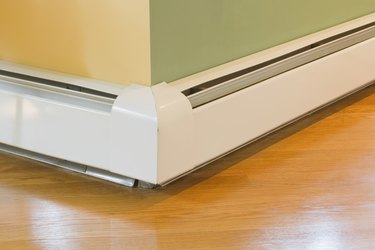
Baseboard heaters use radiant heat rather than forced air to heat a room. The rooms are heated by conduction, as the warm air from the heater rises and cool air falls to the floor. They can be cost effective for single rooms, but are more useful as a supplemental heat source.
Function
Video of the Day

Many people use baseboard heat in one or two rooms in addition to a furnace with ducts. Sometimes homeowners add baseboard heat to an addition such as a loft or a four seasons room rather than run new ducts to the forced air furnace. Additionally, if a family uses only one or two rooms most of the time, they may add baseboard heat in those rooms.
Video of the Day
Cost

To determine the cost of operating a baseboard heater, look at the wattage of the heater, and divide by 1,000 to get the kilowatts. Multiply the kilowatts by the number of hours the unit will run per day. From an energy bill, look at the cost per kilowatt hour for electricity and multiply that number by the number of hours per day. That gives the cost for one day of running baseboard heat.
Considerations

Completing these calculations for even one room will likely give a cost of about $400 for baseboard heat in one room, 12 hours a day, for a month. Clearly, heating an entire home with baseboard heat is not as efficient as other heating methods for an entire home.